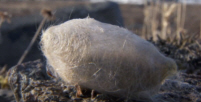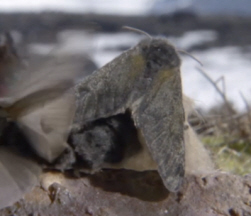Woolly Bear Caterpillar
Life in the Deep Freeze
Woolly Bear Caterpillar
The woolly bear caterpillar does not need the warmth from flowers to kick-start its spring. It’s always the first insect to appear after the snow
retreats and the story of how it does so is truly astonishing. At the start of spring, the caterpillar eats as fast as it can, as indeed it must, for
this far north, the season will be brief.
The days shorten only too soon, but the caterpillar has not yet got enough reserves to transform into a moth. It can’t leave the Arctic, for it can’t fly, so it settles down beneath a rock. The sun’s warmth rapidly dwindles. Beneath the rock, the caterpillar is out of the wind, but the cold penetrated deep into the ground. Soon, its heart stops beating. It ceases to breathe, and its body starts to freeze – first its gut, then its blood.

Woolly Bear Cocoon
The following spring. After four months of darkness, the Arctic begins to thaw. And the caterpillar… - …rises from the dead. By the time the first
shoots of Willow appear in the early spring, the woolly bear is already eating. But no matter how fast the woolly bear eats, it will not have time to
gather enough food this year, either, and the cold closes in once again.

Woolly Bear Moth
Year after year, the caterpillar slows down in the autumn and then freezes solid. But eventually a very special spring arrives. This one will be it's last. It’s now 14 years old – the world’s oldest caterpillar. Its remaining days now become frantic. It starts to weave a silk cocoon. Inside, it's body is metamorphosing into one that can fly and search, abilities that will be crucial in the days ahead.
It’s waited over a decade for this spring and now, its time is near. All across the Arctic, moths are emerging. After completing their 14-year preparation, they now have just a few days to find a partner and mate. No life illustrates more vividly the shortness of the Arctic spring or the struggle to survive in this most seasonal of places.

